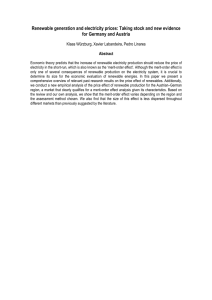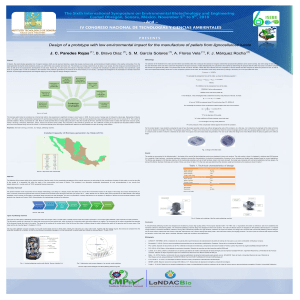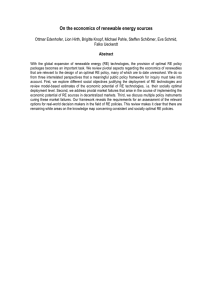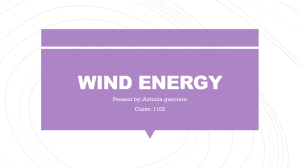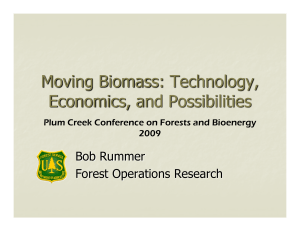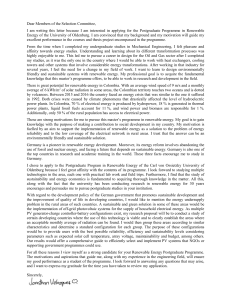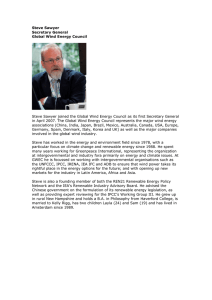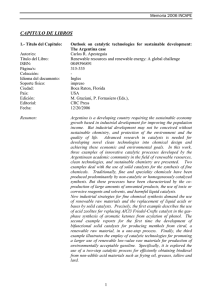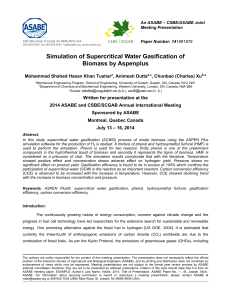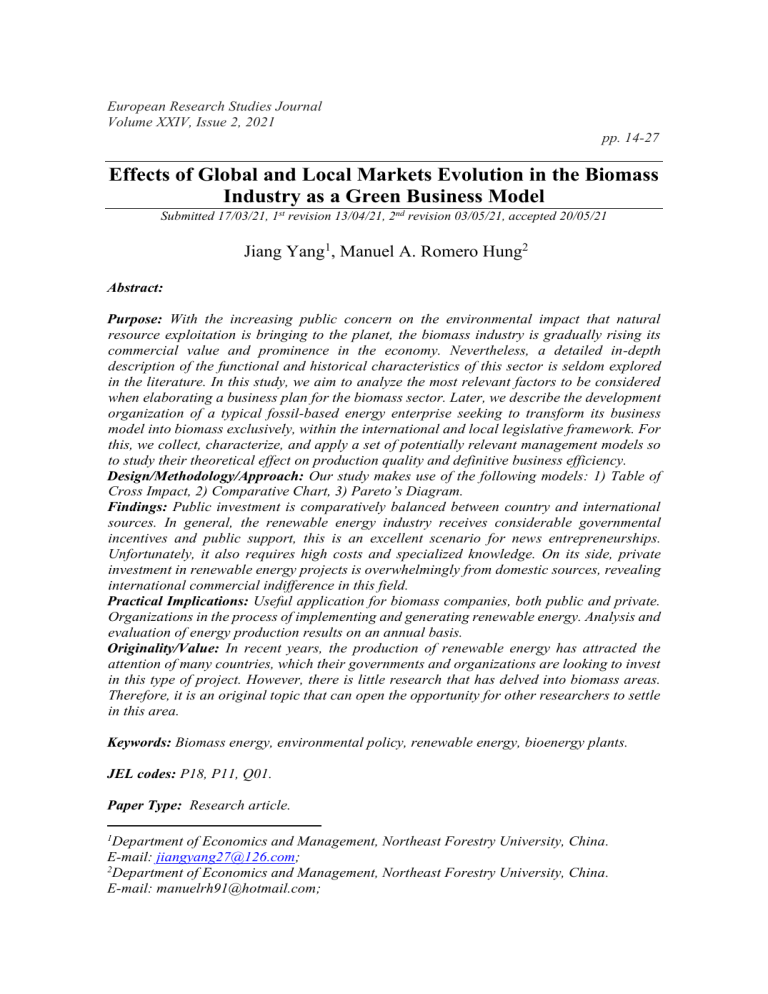
European Research Studies Journal Volume XXIV, Issue 2, 2021 pp. 14-27 Effects of Global and Local Markets Evolution in the Biomass Industry as a Green Business Model Submitted 17/03/21, 1st revision 13/04/21, 2nd revision 03/05/21, accepted 20/05/21 Jiang Yang1, Manuel A. Romero Hung2 Abstract: Purpose: With the increasing public concern on the environmental impact that natural resource exploitation is bringing to the planet, the biomass industry is gradually rising its commercial value and prominence in the economy. Nevertheless, a detailed in-depth description of the functional and historical characteristics of this sector is seldom explored in the literature. In this study, we aim to analyze the most relevant factors to be considered when elaborating a business plan for the biomass sector. Later, we describe the development organization of a typical fossil-based energy enterprise seeking to transform its business model into biomass exclusively, within the international and local legislative framework. For this, we collect, characterize, and apply a set of potentially relevant management models so to study their theoretical effect on production quality and definitive business efficiency. Design/Methodology/Approach: Our study makes use of the following models: 1) Table of Cross Impact, 2) Comparative Chart, 3) Pareto’s Diagram. Findings: Public investment is comparatively balanced between country and international sources. In general, the renewable energy industry receives considerable governmental incentives and public support, this is an excellent scenario for news entrepreneurships. Unfortunately, it also requires high costs and specialized knowledge. On its side, private investment in renewable energy projects is overwhelmingly from domestic sources, revealing international commercial indifference in this field. Practical Implications: Useful application for biomass companies, both public and private. Organizations in the process of implementing and generating renewable energy. Analysis and evaluation of energy production results on an annual basis. Originality/Value: In recent years, the production of renewable energy has attracted the attention of many countries, which their governments and organizations are looking to invest in this type of project. However, there is little research that has delved into biomass areas. Therefore, it is an original topic that can open the opportunity for other researchers to settle in this area. Keywords: Biomass energy, environmental policy, renewable energy, bioenergy plants. JEL codes: P18, P11, Q01. Paper Type: Research article. 1 Department of Economics and Management, Northeast Forestry University, China. E-mail: [email protected]; 2 Department of Economics and Management, Northeast Forestry University, China. E-mail: [email protected]; Jiang Yang, Manuel A. Romero Hung 15 1. Introduction Throughout history, mankind has been vitally dependent on energetical resources to survive and carry out its daily activities. However, many disturbances and imbalances in the environment have occurred in recent decades that have ultimately harmed humanity. According to Velasco (2009) due to the unprecedented rise in urban population of recent decades, demands of the industries with the task of maintaining and solving habits of mass consumption has triggered a frenzy over the extraction of the earth's resources, most of them non-renewable. Indeed, in many parts of the world, natural environment has turn into a severe situation where any possible energy source has become extremely limited or unavailable. The effects of this problem transcend the mere energetic aspect, but also cause lower life quality and social instability. Fortunately, governments all around the world have generated a response to this problem and demanded more conservationist efforts from the public and private industrial sectors, for example: alternative techniques for reusability in agricultural production, elevated taxes in fossil-based fuel production and distribution, promoting a reasonable economic framework for the profitability of renewable energy business. In the last decade, international and local institutions have invested a great deal into tilting dependence on energy towards the infinite and renewable sources, by supporting technological and scientific innovation to develop and expand those industries relevant to the area, such as wind, hydraulic, solar, geothermal and biomass. Since 1970, scientists started to become concerned about the impact in nature of fossil fuels exploitation, alternatives were studied to substitute it for reliable, less polluting, and controllable production costs, as mentioned by Bracho and Murova (2017) in their analysis. Later, due to pressure of people organized through NGOs and street demonstrations, international institutions like United Nations (2016) finally started to advocate over the problem. By extending complaints about uncontrolled fossil fuel usage and promoting renewable energy investment goals, the United Nations gave a step up in the establishment of sustainable and affordable clean energy development, integrating bioenergy into an end-use application, buildings, transport, and industry. In the context of United Nations directions, affiliated governments of the international community must be confirmed with the projects of global renewable energy, by respecting and patronizing the standards from the Institute for Energy Economics and Financial Analysis (2018) for control and management of gas emission into the energy use, and the memorandum of Kyoto Protocol (1998) for accepting the agreements about the global warming and the damage effects with CO2 emission. According to Zia (2012), using Biomass for energy from food crops, burning wood, burning municipal solid waste, collecting landfill gas or biogas, and the excessive use of liquid biofuels such as ethanol and biodiesel has negative effects, one of the consequences that affect the environment is the creation of pollution and harming the ozone layer. In other words, and supporting this description, the organization Eficiencia (2020) demonstrates the disadvantages of low calorific value, the large 16 Effects of Global and Local Markets Evolution in the Biomass Industry as a Green Business Model space than other types of fuels, distribution channels are not yet as widespread as those for other fuels, and the large amounts of industrial plants are needing. 2. Global Movements with the Production and Consumption of Biofuel In Figures 1 and 2, we present the regions with the most usability of consumption and production of biofuels and fossil oil, such as the United States of America, the People’s Republic of China, and the Republic of Brazil. The whole European Union also has been added, gathering all its states within a single entity. The total results from the year 2012 until 2018 from the reports done by each year were calculated and unified for this graphic. Figure 1 refers to the Biofuel Production, some points of views, we can define that the annual average in the oil price rose to $73,1 per barrel, up from $54.19/barrel, which is growing by an above average 1.4 million barrels per day, or 1.5% in China that is generation around 680,000 b/d and the US is doing a 500.000 b/d, in conclusion, were the largest contributors to growth. The global oil production is around 2.2 million b/d. In the cases of the refinery, the results show a 960.000 b/d, down from 1.5 million in 2017, based on the data of EIA (2017). It is important to consider the verification of the number of results given over the years, since it defines profitability and the impact on renewable energy companies, which requires an indepth study of various areas that may be involved, to specify the effectiveness of a project and stay long-term. In Figure 3, named: “fossil oil production and consumption”, appears like the United States of America in the top high rank of fossil consumption. Most of them, some supplies and derivates of oil should need to be imported and commercialized abroad to satisfy the demand of its relatives. Figure 1. Biofuel Production (Million Tonnes Oil Equivalent) European Union United States of America Republic of Brazil Republic Popular of China Source: Own study. Jiang Yang, Manuel A. Romero Hung 17 With the data observed in Figure 2, Fossil Oil Production, according to the reports from British Petroleum Company “BP Statistical Review of World Energy” (2019), represents the movements of the year as shown in Figure 2. The consumption of biofuel by the last years has been increased, in comparison to the production that is keeping in a line of margin. We can observe several factors occurring in this case, such as technological developments, supplies, and demands of products that requires biofuel for daily use, parallel with the increasing percentage of the population, due to these results, governments are trying to improve renewable energy industries, even though the high demand that is happening is not being satisfied. This leads to a future risk in the depletion of these biofuel resources. The continent of Europe, the United States of America, and the Republic Popular of China are the most consuming biofuels, in the next position is the Republic of Brazil. The consumption of biofuels from China is increasing in the pyramid, however, the European Union has been consumed and established a high percent and keeping the line. It can be due to the economic activities executed in the step of the time. In the global biofuels production is growing in 0.9%, below the 10-year average of 14.3%, for example, Brazil is getting a +6.8% extra and the US by +2.9% for essentially all net increase. Figure 2. Fossil Oil Production (Million Tonnes Oil Equivalent) European Union United States of America Republic of Brazil Republic Popular of China Source: Own study. 3. Theoretical Review Academic literature synthesizes some definition about the biomass, following every material of biological origin excluding those that have been encompassed in geological formations undergoing a mineralization process. The fossil fuels such as Effects of Global and Local Markets Evolution in the Biomass Industry as a Green Business Model 18 coal, oil, and natural gas are excluded from this definition of renewable biomass, as described by the White House (2016). Biomass can be classified as natural, residual, or energy crops. According to Daysi and Mireya (2012; 2020), if its state is considered, it can be solid, liquid, or gaseous. The biomass is a relevant element to take advantage of the wastes from natural consumption. In other terms, it may be considered like the organic material originated in a spontaneous or provoked biological process, usable as a source of energy. To measure the productivity from this ecosystem, is established two factors: ➢ ➢ Gross productivity: is a measure of the rate at which organisms assimilate energy within the trophic level. Net Productivity: it is the energy measured in calories, stored in chemical compounds. Concerning management models with the "theory of business", Birkinsha and Goddard (2009) mentioned that the definition of management models contains three parts: assumptions about the environment of the organization, the core competencies needed to accomplish the organization including its mission and specific objectives. Some procedures steps also are being included: design, quest, scientific, and discovery. One important factor consists of reaching individual and collective goals by working with and through human resources to improve the project. There are several ways to a management model, such as the rational goal model, internal process, human relations, open systems, and ethics. The elemental concept of Business Strategy is referred to combine actions and decisions performed in the plan to accomplish goals and secure a competitive position in the whole market, as well as described by Baye (2009). It means, to include the control, key components, management, level, and corporative mode are the main elements to develop a strategy. It is essential and necessary to apply for all the enterprises, which is convenient to follow some procedures. In another fact, the report from Renewable Energy Policy (2016), the biomass is included in the meaning point concerning the clean and recycle fount of energy, in addition to biofuels, hydroelectric, solar, because it is obtained from natural resources inexhaustible, available to regenerate by own ways. Nowadays, the application of external and internal forces on the natural system can influence other procedures in the advantages of its position. 4. Methodology In ways to create the present investigation, it has been extracted by official websites and institutes that belong to the industries of renewable energy and database from analysis of statistics referred to the topic, finding more than 50 results, including papers and annual reports. For the procedures of experiments and analysis, the methods show the next points: Jiang Yang, Manuel A. Romero Hung 19 Table of Cross Impact: According to the concepts used by Tableau (2019), it is one of the forward-looking technologies used to explore prospects based on a series of events that may or may not happen in a period. In other words, the term event is referred to the hyphenation that could be true or not, depending on whether the event occurs within the analyzed time frame, which might affect the relationship between the status variable. The number of resources has been counted, then applied in different sections, and evaluating its progress status. We can define the better suitable fact for proposal decisions related to management issues. The data has been extracted from the website CA California (2017), which the original results about Power Public Plants are available. Pareto’s Diagram: The procedures and methods attached by the EIA (2020) mention that Distribution ABC is used to organize data in ways to measure the relevance and importance of worked resources and their elements. The bars represent frequency, and it is aligned in the shortest until the longest track, demonstrating a panorama situation where the analyst must attend. Using this method might be possible to enter the analysis of failures in properties collected in the investigation. We have numbered the number of repetitive cases and divide the characteristics. After we proceed to apply the method. Comparative chart: The information organized and collected from different scopes (essays, websites, institutions, database) is embodied into lists available to make a comparison, identifies the similarities and differences between a variety of essential elements that implies in the analyzed case, exposing other results and its effects developed in a different situation, as well as describe Amarilis and Alan (2011). Tables 2-3 gathered the tasks of evaluation (legal basis, management procedures, economic situation, sustainable development), followed by the description, which mentions the policy of actions applied. We have focused on the line of orders within the years 2006 until 2019, where appears the total results produced in biofuel energy and other components, after proceeding how it influences in the status of enterprises. The mentioned chart from the table 2-3 is an equal reference by the investigation from McKendry (2002), which had done an investigation in Brazil and the UK concerning to the wood crops biomass. Besides, we have supported statistical studies of Biofuel and Fossil (production and consumption) and how is the comparison, related to the areas in high demand that directly influence the conditions of the biomass market, and why does the establishment of production affect these projects of renewable energy. In supports of the British Petroleum Company BP (2016), suitable biomass species could replace conventional fossil fuel energy sources. 5. Results 5.1 Case 1: Comparison of Status Biomass Enterprises (cross-impact) As a deductive analysis, taking as an example, we have surveyed 105 cases of enterprises dedicated to biomass power public plants listed until the year 2018 in the 20 Effects of Global and Local Markets Evolution in the Biomass Industry as a Green Business Model region of California, USA. In the description part of this Matrix Cross Impact is doing possible analyzing the statistics results, the squares of the vertical, shows the plus of status projects, in the horizontal box, represents the number of resources attached in Table 1. Table 1. Number of resources Resources Fischer Gasifier Biomass Unknown Gasification Thermal Chemical Recovery Co Fire H2 Gasifier Boiler Circulating A.P C.P I. LIQ. OP. PRO. 1 1 0 0 0 0 1 0 0 0 0 0 1 4 16 8 15 0 4 22 0 4 0 4 3 2 1 0 3 0 1 0 0 0 3 2 0 0 0 1 0 0 0 1 2 0 2 1 1 0 0 0 0 0 0 0 0 0 1 0 12 30 19 13 24 7 Source: California Energy Commission - Power Public Plant total 2 1 44 34 9 6 1 6 1 1 105 5.1.1 Description of acronyms AP: Approval Projects: They are proposals accepted to progress with the planning, after building the status of the tasks into a selected period of time. Canceled Projects: Some objectives are not concluded, due to the procedures are not well completely known, even not suitable with the economic, environmental, or social situation. The projects are being announced, but the design is subjected to changes to global policy. Idle: In this sector are the unknown part with the objectives, not described and detailed. There is a lack of data and a deficiency in the definition of research. However, it will not be excluded. Liq: liquidated: In this part, it means about eliminate the projects, excluded from the list. Op: operational: It is included in the list of the plants in advance to do functionality with resources already accepted and approved, looking forward to continuing with the operations. Pro: In Progress: Several organizations are investing in the plants, which are searching the future by the obtained results. In the vertical square: The approval projects in the same year reach 12 cases, canceled projects demonstrate 30 cases, the idle situation with 19, liquidated numbers are 13, operational cases are 24, The planning status of progress, embrace a total of 7 variables, which 2 are continuing with thermal resources. In horizontal square: There are 44 cases involving biomass solid fuel, most of which are not recognized and cannot promote the development of resources. Therefore, the trend is on the rise to avoid continuing the business of 4 canceled projects, 8 Jiang Yang, Manuel A. Romero Hung 21 eliminated projects, and 16 unknown projects. However, operating enterprises must be realized by 15 / 24 of biomass, the rest of them are location, thermal, and co-firing. Another analysis was made concerning "unknown" projects 34, which have many reports, which may vary depending on the resources provided. In most cases, they do not have a fixed parameter to develop, and they have a clear vision. As the result, these parameters are canceled. The biomass solid fuel has the more comparative part for being developed, most of the enterprises attempt to increase the number of productions from this fact, considered as a suitable option to tilt on these areas in comparison of biomass, relative to other non-growing features, also contributes to production and research to include other parameters. The renewable energy policy also describes alternatives to this energy production. 5.2 Case 2: Pareto’s Diagram Figure 3 presents Pareto’s Diagram in the status of biomass public plants using the same data from California Energy Commission – Power Public Plants (2018). This diagram shows other results that could be proved on future decisions, also to measure the importance level to check the quality of resources applied. Figure 3. Pareto’s Diagram in status of biomass public plants. It is the results obtained and evaluation for priority. Source: Own study. The results analyzed, offers a total result in the 80% that embraces four areas: canceled projects, operational, idle, and eliminated. ICT means that part of the project has addressed development-related issues, including the cancellation of project (30) and liquidation project (13), which is a total collection of 43, because the performance to be achieved is not suitable for the environment, the economy or at all. The operational progress is a status where is being evaluated the duration, quantity, expected situation, extension, and reaction,in accordance attached with the score from the Department of Energy (2015). Approved projects and progress may be made 22 Effects of Global and Local Markets Evolution in the Biomass Industry as a Green Business Model after the completion of the projects, even if the projects may carry out work. The cases before analyzed are demonstrations of methods that could be applied. The latest four variables, on the left-hand side, are a demonstration of where managers and supervisors need to focus and reassess the conditions for achieving this impact. 5.3 The Common Problems Attached with the Projects of Biomass Table 2 describes the general policy applied in general for all the projects of biomass, the declarations have been gathered by the compilation of investigations and reports from institutes. Table 2. Evaluation and Policy Name Legal Basis Management Procedures Economic Situation Socio-ecological system Guidance Sustainable Development Description The U.S Department of Energy (DOE’s) Bioenergy Technologies Office (BETO) includes partnerships with public and private investors that support technologies and methods, in ways to produce cost-competitive advanced biofuels from biomass resources. Techniques of work administration used in the factory, like Short Rotation Woody Crops (SRWCs), Integrated Resource Management (IRMT), Manitoba Conservation and Water Stewardship (CWS), are the elements that progress into the projects. The multiple projections were done in the consumption of Biomass for cellulosic biofuels of electric power, fossil fuels, manutention of oil, are relative with the market flow. Also is evaluating the production from energy crops, forestry residues, urban wood wastes. The variety of sectors from the city, such as industries, commercial zones, factories, houses, are employing green models of sustainability and conservation of the environment. Developed by U.S Green Building Council (USGBC) Exist guidelines to apply in the land plants of biomass energy, evaluating elements like spatial wildland fire, characterization of micronized wood and energy-size relationship in wood comminution, and sampling aboveground biomass and carbon in mature central hardwood forests. The workshop on IEA Bioenergy was an integral part that is covering bioenergy-related topics, policies, and programmers. Some tasks like emission, production of feedstock, submission of GHG, certification provided by the control government, governance, conservation, and soil. Source Manitoba (2005) USGBC (2020) Reeder (2011) (Richard 2011; CARB 2015) (Sierra Club 2015; IEA 2013) Bhaskar and Pandey (2015) Source: Own study. In Table 3, appears the name of the most common problems inside one organization that works on biomass contents, description of issues analyzed, and possible solutions proved in other investigations originated from different regions. We have selected this option, in ways to provide research in other countries, extracting and comparing the applied solutions, because it also is described similar troubles like is running in California’s states. The table of comparison is being done, in reasons to implement a hypothetical solution to the characteristics involved. Jiang Yang, Manuel A. Romero Hung 23 Table 3. Common problems and solutions done. Name of problem Poor Investment of Resources Description There is the existence of low investment of budgets for developing a big magnitude of the biomass industry. Weakness Infrastructures The lack and strengthens of supplies to guarantee the quality is the main problem part. In some regions is not a well-established harvesting system nor conventional treatments to process the biomass, in fact, it is limited. Due to the paths and ways to bring the resources, and localization of renewable industries is hard to access and make easy the transport of biomass. of Method of Short Rotation Wood Crops (SRWCs) Weak connection transport biomass Route: and of Limited Market and expansion of resources Poor attention from the government Secondary Effects and Pollutions Cost of Operation and Maintenance Source: Own study. Only in specific regions are established a focus on some natural waste, moreover, does not have the adaptability to process another resource. Some governments are paying attention to renewable energy, but mostly of them are not following the right procedures to create a promotion for increasing the biomass projects. The process of biomass generates secondary effects with the emission of NOx, SO2, and CO2 An amount of budget is demanded supply and keep continuously the machines and structures for the industries. Sometimes expenses exceed the level of income, increasing passive values. Possible solutions The optimal administration and clear management of finance will make possible the procedures. Private and public investments are required to plant an optimal disposition to convince the expansion of biofuel projects. Improve and upgrading, as well as the structures and technology, also using in a good mode the weakness of materials, could facilitate the infrastructure. The rotation will be implemented into periods from 3 or 4 years, extracting a vary of 5 to 30 tons. Reference Rusco (2012) In some studies, referred to Bolivia, consist of implementing a strategic plan called Biomass Collection Points (BCPs) in the geographic zones and measuring its features of regional environment, distributing, and transporting the species of biomass to appropriate places, saving the resources in specific regions for their usability, might arrange optimal solutions. Scientific studies should need to analyze the plants, agricultural zone, wastes from the city, to make availability for applying to the territories. Biomass fuel is expensive in comparison to other fuels. The policies referred to renewable energy must need to be included in the projects of government and bring attention to its development. Also gathering the public and private sector for start with the industries of renewable energy. Adams et al. (2019) Moya, Tenorio and Oporto (2019) Morato, Vaezi, and Kumar (2019) Brown et al. (2019) Danish and Wang (2019) Use with caution the applied chemical and control the generation of ethanol, CO2 emission. Following the established rules for security and industrial hygiene. IRENA (2012) It is necessary to implement optimal conditions to control the expenses and make a correct distribution of investments, reducing the expenses that is not involved in the biofuel’s generation. Also, the preparation of personal is included to have good usability and performance of materials. Gielen (2012) 24 Effects of Global and Local Markets Evolution in the Biomass Industry as a Green Business Model 6. Conclusions We present compiled investigations from different areas, including reports, conferences, videography, that demonstrate the effectiveness, operation, and quality of the private and public sectors in the production of renewable energy. One of the most important challenges to the industry is the high cost and price to implement the business model. The public plants promoted by the rules of government suffer almost identical challenges to their private counterpart, and likewise, neither complies with the requirements of the environmental conditions of the area. For instance, some plants making use of methods, such as pyrolysis, are not approved due to the demonstrated damage to the environment that it could generate. However, the power plants are no better than coal plants, which are the most polluting. They work by burning plant material, which releases CO2, a greenhouse gas that causes global warming. As opposed to real clean and sustainable solutions like wind, and solar energy. But CO2 the plant release is the same as O2 the plant produce before. It is almost near to carbon neutral. According to other conclusions drawn, to generate more energy, more waste from land and cities is required. It became a pollution problem since garbage dumps and organic materials produce methane, which contributes to the greenhouse effect. Knowing all this type of inconvenience, companies focused on this area must evaluate and manage their functions so as not to contribute to these effects that harm the environment. The implementation of biomass production for the enterprises is increasing over time, becoming a more competitive challenge, in reasons for the effectiveness of this plan to produce renewable energy. The models of business and strategies are important facts to include and improve in the methods. Many enterprises are looking for the best methods and ways to apply to their organization, understanding the social, political, and economic conditions respecting the place that they could expand. Furthermore, the teams need to work on decisions and evaluation for improving and rectify the implementation of biomass model solutions, such like optimize maintenance resources, optimize capital equipment life, minimize energy usage, minimize inventory on hand, in ways to proceed with one of the most important elements from the construction of organization. Most of investments industries comes from the local source. The green policy is one of the options that governments want to implement, in order to organize strategies of actions relating to the environment and climate changes (Heemanshu, 2011). The public investment is balanced between country and international financing. Many efforts have been attempted to execute for the emergence of new companies by scientific teams to implement non-renewable energy generation and distribution methods. Private companies do have the option for openings and specifications in Jiang Yang, Manuel A. Romero Hung 25 functions of biomass production, although they require a higher cost and work. The investors are overwhelmingly domestic renewable energy projects. The research was accomplished an extensive literature review concerning Business Models for Enterprises and Biomass Fuels to try to identify the possible combination. Under this context was clearly defined the strategies for tracking the control process and application of the effectiveness of renewable energy. References: Adanza, E.G. 2006. Research Methods: principles and applications. Philippines: Book Store. Adams, D.M., Latta, G.S., Crandall, M.S., Guerrero, I.G. 2019. The importance of incorporating intertemporal and spatial long market dynamics in projections of residues-based biomass supply for liquid biofuel production in western Oregon and Washington, USA. Journal of Forest Policy and Economics, 106, 1019-1057. doi:10.1016/j.forpol.2019.101957. Amarilis, L., Bond, A. 2011. Investigating the effectiveness of environmental assessment of land use change: A comparative study of the approaches taken to perennial biomass crop planting in Sao Paulo and England. Institute of Technological Research, 4-6. doi:10.10.16/j.biombioe.2011.02.050. Bhaskar, T., Pandey, A. 2015. Advances in Thermochemical Conversion of Biomass. doi:10.1016/B978-0-444-63289-0.00001-6. British Petroleum Company BP. 2016. Statistical Review of World Energy - Global Report. Available at: https://www.bp.com. Bracho, P., Murova, O.I. 2017. Financial Performance Analysis of Corn-based Ethanol Enterprises in the U.S. Department of Agriculture, Regional Office, 2-4. Birkinsha, J., Goddard J. 2009. What is your Model Management? Management Review, Vol. 50-2, 81-83. Cambridge: MIT Sloan. Baye, M. 2009. Managerial Economics and Business Strategy, 6th ed. New York: McGraw Hill. Brown, M., Favero, A., Thomas, V., Banboukian, A. 2019. The economic and environmental performance of biomass as an “intermediate” resource for power production. Journal of Utilities Policy 58:52-62. doi:10.1016/j.jup.2019.04.002. California Energy Commission .2020. California Biomass and Waste-to-Energy Statistics and Data. Biomass Consumption Repository. Available at: https://ww2.energy.ca.gov/almanac/renewables_data/biomass/index_cms.php. California Energy Commission .2020. Energy Facility Status, Power Plant Projects since 1996. Power Plants repository. Available at: https://ww2.energy.ca.gov/sitingcases/all_projects_cms.html. California Air Resources Board. 2015. Biomass-Derived Fuel Guidance: for California’s Mandatory GHG Reporting Program. Report and Regulation. 1-2. California: IEA. Corell, H. 1998. Kyoto Protocol to the United Nations Framework Convention on climate change. Letter presented at conference of United Nations, New York, March 12. Danish, Wang Z., et al. 2019. Does biomass energy consumption help to control environmental pollution? Evidence from BRICS countries. Sci Total Environ 670:1075-83. doi:10.1016/j.scitotenv.2019.03.268. EIA. 2017. 2020. California Energy Consumption Estimates. Energy Consumption Repository. Available at: https://www.eia.gov/state/?sid=CA#tabs-1. 26 Effects of Global and Local Markets Evolution in the Biomass Industry as a Green Business Model EIA. 2020. Survey: Form EIA-923 detailed data with previous form data (EIA-906/920). Available at: https://www.eia.gov/electricity/data/eia923/. Gielen, D. 2012. Renewable Energy technologies: cost analysis series - Biomass for Power Generation. Vol.1, Issue 1/5. Canada: Power Sector. Heemanshu, J., 2011. Green ICT Organizational Implementations and Workplace Relationships. Available at: https://www.igi-global.com/chapter/green-ictorganizational-implementations-workplace/48425. IRENA. 2012. Renewable Energy Technologies: cost analysis series. Biomass for Power Generation. Volume 1: Power Sector Issue 1/5. Retrieved from https://www.irena.org/documentdownloads/publications/re_technologies_cost_anal ysis-biomass.pdf. IEA Bioenergy. 2013. Environmental Sustainability of Biomass. Summary and Conclusions from the IEA Bioenergy ExCo68 Workshop. 14-15. California: IEA. Institute for Energy Economics and Financial Analysis (EEFA), Oil Change International, 2018. Off Track: how the international energy agency guides energy decisions towards fossil fuel dependence and climate change. Cleveland, OH: Oil Change International. Manitoba. 2005. Conservation and Water Stewardship Forest Practice Guidebook: Biomass Management - Guidebook. Canada: Ltd. McKendry, P. 2002. Energy Production from biomass (Part 1) overview of biomass. Bioresource Technology 83:37-46. doi:10.1016/S0960-8524(01)00118-3. Morato, T., Vaezi, M., Kumar, A. 2019. Developing a framework to optimally locate biomass collection points to improve the biomass-based energy facilities locating procedure – A case study for Bolivia. Journal of Renewable and Sustainable Energy Reviews 107: 183-99. doi:10.1016/j.rser.2019.03.004. Moya, R., Tenori, C., Oporto, G. 2019. Short Rotation Wood Crops in Latin American: a review on status and potential uses as biofuel. Journal of Wood Science and Technology. Energies 2019, 12, 705; https://doi.org/10.3390/en12040705. Portal Digital de Eficiencia Energética y Sostenibilidad. 2019. ¿Qué es la biomasa? (What is the biomass?). Available at: https://e-ficiencia.com/que-es-la-biomasa/. Reeder, L. 2011. Guide to Green Building Rating Systems: understanding LEED, Green Globes, Energy Start, the National Green Building Standard. 91-110 doi:10.1002/9781118259894. Richard, N. 2011. Biomass in the United States energy economy. Conference presented in EIA:US. St. Louis, Missouri, November 23. Rojas, D., Mireya, R., Goldwasser. 2012. Bioenergia con base en la biomasa (Bioenergy base in the biomass). Argentina: Academia de Ciencias Fisicas, Matematicas y Naturales. Rusco, F. 2012. Biofuels Infrastructure in the United States: status and future challenges. Washington: OECD. Sawin, J., Kielmanowicz, D., Saraph, A. 2016. Energías Renovables 2016: reporte de la situación mundial. Francia, Paris. [Renewable Energy 2016: report of current world situation]. Renewable Energy Policy Network REN21, Paris, France. Available at: https://www.ren21.net Sierra Club. Form EIA-923 detailed data with previous form data (EIA-906/920). Biomass Guidance. Available at: https://www.sierraclub.org/policy/energy/biomassguidance. Tableau. 2018. Create a Pareto Chart. Available at: https://help.tableau.com/current/pro/desktop/en-us/pareto.htm. Jiang Yang, Manuel A. Romero Hung 27 USGBC. LEED .2019. Rating system: better buildings equal better lives. Available at: http://new.usgbc.org/leed. US. Department of Energy. 2015. Bioenergy Technologies Office: Growing America’s Energy Future. Available at: https://www.energy.gov/eere/bioenergy/about-bioenergy-technologies-officegrowing-americas-energy-future. United Nations. 2020. Ensure access to affordable, reliable, sustainable, and modern energy. Available at: http://www.un.org/sustainabledevelopment/energy/. Velasco, J. (2009). Energías Renovables (Renewable Energy). vol. 12, 217-20. Barcelona: Reverté. White House. 2016. Leader’s Statement on a North American Climate, Clean Energy, and Environment Partnership. White House. Available at: http://obamawhitehouse.archives.gov/the-press-office/2016/06/29/leadersstatement-north-american-climate-clean-energy-and-environment. Zia, H. 2012. Biomass for Electricity Generation. Available at: http://www.researchgate.net/publication/265630422_Biomass_for_Electricity_Gen eration.



